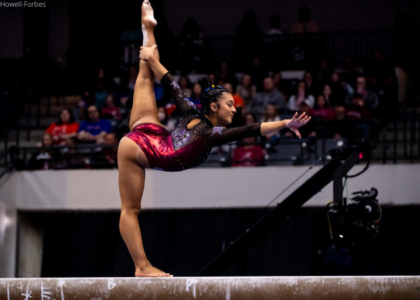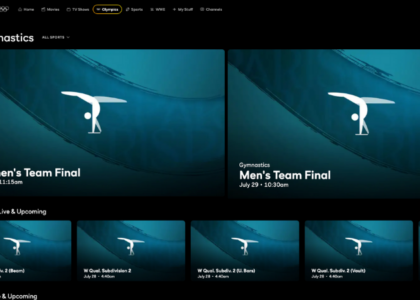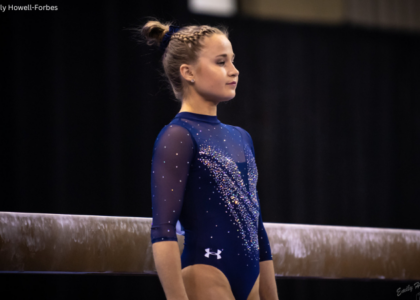Over the past few seasons, the standard of women’s NCAA gymnastics has increased exponentially, and getting a coveted spot on one of the teams is no small feat. College coaches only recruit the top 3% of high school gymnasts in the country, meaning that landing one of the 756 available scholarships across D-I and D-II programs is a huge achievement. Since even securing a walk-on spot at a top school requires high-level skills, how do clubs around the country prepare the level-10 gymnasts who want to pursue gymnastics at the collegiate level?
At GymCats in Henderson, Nevada, Jill Preston, the JO team director, brings over 25 years of experience. Among the club’s notable alumnae are Cristal Isa (Utah ‘23), Selena Harris (UCLA ‘25), and Delaynee Rodriguez (Kentucky ‘26). The current cohort of level 10s at GymCats boasts four CGN-rated recruits: Kailin Chio (LSU ‘24), Macy McGowan (UCLA ’24), Deziray Boykin (uncommitted ‘24), and Kimmara Echols (Missouri ‘25 ). Even with such a strong group of athletes, Preston underscored that success comes from more than just rigorous training schedules and perfecting routines. “We are led by [their] actions towards [their] goals,” she said. “So we’re never gonna push anything on them. But if they have certain goals, we’re gonna try our best to get them there.”
The GymCats’ level 10s train for approximately 16 hours a week, which is crucial for skill development and consistency. Though it may sound like a lot of time, this training load is on the lower end of the spectrum for level 10s across the country. Gym owner Cassie Rice and the coaching staff prioritize the holistic development of their athletes. Rice has “put a lot of energy into educating the kids, the parents, and the coaches,” said Preston. “We think a lot about coaching the whole athlete, or parenting the whole athlete, so that’s been really important.”
Preston emphasizes the importance of maintaining perspective. “We just don’t make anything that important,” she says, recognizing that the memories and experiences gained outweigh the outcome of any single routine or meet. “When they’re 40 years old with a family of their own, they’re not gonna remember if they fell at regionals.”
In Preston’s view, the passion for gymnastics, coupled with talent, is the key to achieving a place in an NCAA program. Reflecting on the accomplishments of former GymCat Rodriguez, who recently finished an exceptional freshman season at Kentucky during which she competed in the all-around in 10 of 14 meets and led off on all four events for much of the season, Preston said, “I was just so proud of her, and I was really thankful that her school trusted her… because, you know, it’s one thing if I would have told them, ‘Delaynee can handle that,’ but for them to actually know that she could and she delivered. It just made me so excited for her.”
She also highlights the importance of high personal standards and genuine love for the sport. “The biggest measure of success about how great a kid’s gonna be at a sport is how much they love it,” Preston asserted. She emphasized that without a deep-seated love for the sport, even exceptional skills may not translate into standout performances.
However, she believes that securing a college scholarship or a walk-on position should not be seen as the sole measure of the success of an athlete’s level 10 career. It’s a big decision to commit to four more years of gymnastics. Alongside the requirements of the sport are the academic demands of earning a bachelor’s degree. While many followers of NCAA gymnastics are passionate fans of professional or elite sport, it’s essential to recognize that college athletes are also students, something that club coaches are well aware of.
Marty Amrich of Stallone Gymnastics in Pennsylvania emphasized how important it is for an athlete to find the right college fit. “Gymnastics will be a major part of your collegiate experience, but you’re going there for school,” said Amrich. And then he asked the question he poses to all would-be college gymnasts: “Where do you want to attend school?”
It’s also important that the gymnasts have the right entrance requirements for the school. Most of Preston’s athletes attend public school, but Amrich has more of a mix, which comes with positives and negatives. Famous alumnae of Stallone’s, Nicole and Natalie Wojcik (Lindenwood ‘24 and Michigan ‘23, respectively) attended online school, which gave them a little more flexibility to manage the four hours a day, five days a week training schedule followed at Stallone’s.
Though there are benefits to the flexibility, Preston has run into recruiting problems in the past when students who didn’t attend public schools had counselors who weren’t as clued in about NCAA rules and requirements. “We find out when they’re a senior that they didn’t take a language and now they’re not eligible and they’re trying to get their four years of language jammed into a semester,” Preston said. “So we’ve always kind of encouraged them to be in a physical school with counselors that know what they need for as far as their eligibility.”
Once the skills have been mastered and the eligibility requirements met, the next step is to narrow down schools they might be interested in and make contact when the window opens on June 15 of their sophomore year. Then on Aug. 1, recruits are permitted to take unofficial and official visits to colleges, and coaches can conduct off-campus contact.
For current Stallone gymnast and future LSU Tiger Elyse Wenner, a four-star recruit in the class of ‘25, Amrich’s advice was invaluable in her recruitment journey. Under the advice of her coaches, she created an Instagram profile which she updated with her skills, training, and competition routines. On June 15, she had roughly 20 calls from colleges who were interested in having a conversation with her. “Narrowing them down was hard, telling people no was hard. I think it came down to, you know, the place,” she said.
One thing that did help her get to know the programs was attending camps. “I’d been to the Kentucky camp for like four years, so I knew a lot about them.” Although she’s unsure what she wants to major in, she is leaning toward business. With a top-100 ranking for their undergraduate business program, in addition to being a school that can challenge for a national title (another one of her preferences), LSU seemed like a good fit. “Obviously, I didn’t know that LSU was gonna come out with the national championship title this year,” she said. “But, you know, that’s great, and going into that is even better now because we have a chance to do it again.”
For Amrich, the recruiting process involves him making a lot of phone calls to help his athletes. “I’ll make some phone calls to some schools this summer to bring them in to see our team train,” he said. “I like to bring in some colleges, even if they’re not looking at a specific athlete, but at the end of the day, the gymnast earns the scholarship. If somebody said to me, ‘you got a scholarship for Natalie Wojcik,’ I’ll say ‘I didn’t get Natalie Wojcik a scholarship. Natalie Wojcik earned herself a scholarship’. I only helped guide her.”
This is a sentiment that Preston shares. “I think there’s a little bit of misconception sometimes by the parents and the athletes. It’s like if you just do more on the recruiting side, you’re gonna get a scholarship and we’ve just really found that the athletes that have something the college wants, they’re gonna get a scholarship, like you really don’t have to do a lot.” This is one of the things that guides their ethos, though it doesn’t mean the gym doesn’t take action to help their athletes succeed. In fact, they have a Snapchat where they post almost every turn the girls take. “I know a lot of the college coaches appreciate that,” she said. “They can kind of see not just the highlight reels, they can see the mistakes and how they’re reacting to mistakes and changes that they’re making.”
When coaches come to visit Stallone Gymnastics, Amrich will put all the age-eligible athletes in one group and invite the coach down on the floor so he can talk them through what they’re doing and why they’re doing it. “I can then communicate with them and I get to ask them [things like], ‘what are you looking for? What are you trying to do in your recruiting process? How many spots do you have available for that year? How many walk-ons are you taking?’ Then we’re opening a conversation and then I can help get a read as to where my athlete might stand and what we need to do in the immediate future to help them become more recruitable for that coach.”
For Wenner, having college coaches observing practice was really fun. “We had them in like once a week,” she said. “[My coaches] have long conversations with them. But I think it gets our whole team to do better and work harder for what we could have.”
Wenner grew up having Natalie Wojick as a role model. “I’ve known her since I was 7 or 8 and I always kind of looked up to her, and then she went to college and did great and won the AAI award,” said Wenner. “They have a banner in our gym with all her accomplishments and I’m like ‘ok I wanna do the same’”
For Wenner, it wasn’t until she qualified for the Nastia Liukin Cup that she realized she could compete on a level with the top gymnasts in the country. Her coach also saw this change in her. “She kind of started putting it all together and got a little calmer at competitions, which helps,” Amrich said.
Once an athlete has been recruited, committed to a school, and signed a National Letter of Intent, it can feel like a long wait to get to college. For Amrich, keeping his gymnasts healthy is a key goal, regardless of whether they plan to compete at college. “Gymnastics isn’t fun if you’re in pain. If I can keep them healthy, that’s important and then keep them enjoying the sport of gymnastics,” said Amrich. “[Then] when they go off to college, I always say ‘I want to see you in college be better than you were when you left my gym.’”
This is something that’s important to Preston, too; she is delighted when she sees her athletes continue to improve in college. Speaking of UCLA’s Selena Harris, she said, “She’d been wanting to do a double layout on the floor since she was with us and we always worked it and it just never came…I was speaking to Janelle [McDonald, the UCLA head coach] at nationals and she’s like, ‘Selena [told me she] wanted to get a double layout and she made it happen.’ For Preston, this tells her that they’re being successful at coaching for college success. “I love watching them go to college and get better at gymnastics because that makes me feel like we really set them up,” said Preston.
Ultimately, this is why Preston does what she does. “At her [Harris’] age she could kind of just be like, ‘you know what? I’m done learning new things. I’m good’. But instead she took it upon herself to make it happen. And when I’m seeing them take charge of their lives as young women, it makes me really, really proud,” said Preston.
The best level 10s in the country are not only capable of bringing guaranteed scores to their programs, but they also have intrinsic motivation and a desire to continue to improve, even in college. As level 10 gymnasts navigate the recruitment process, coaches like Amrich and Preston offer guidance and support, but the competition is deep. Ultimately, it’s the athlete’s dedication and talent that earns them scholarships or walk-on spots on an NCAA team. And then it’s up to their hard work and love of the sport to make their college careers all that they hope they could be.
READ THIS NEXT: Recruiting Roundup: April 2024
Article by Katie Couldrey




